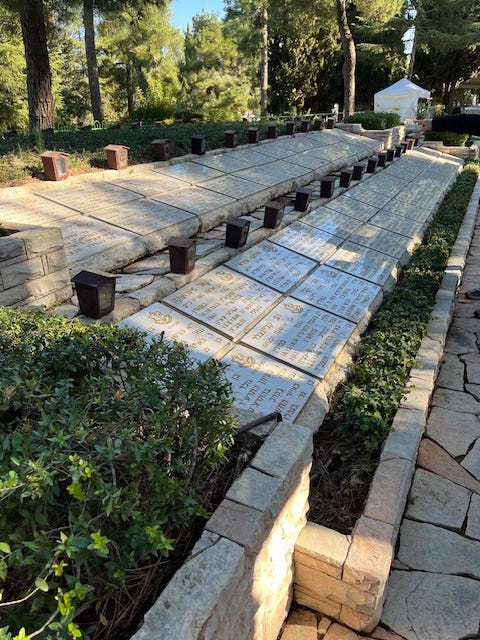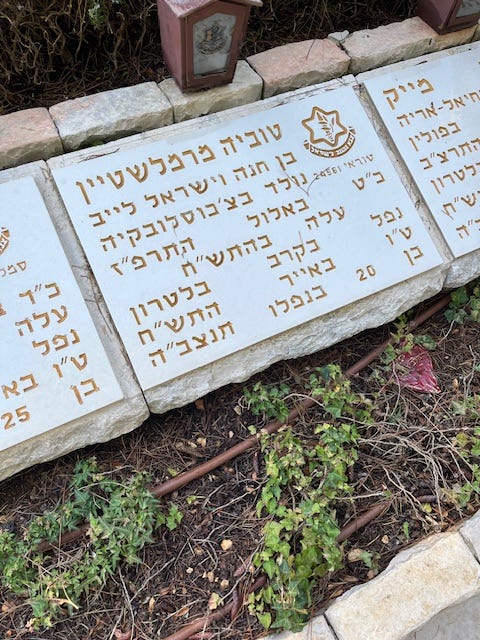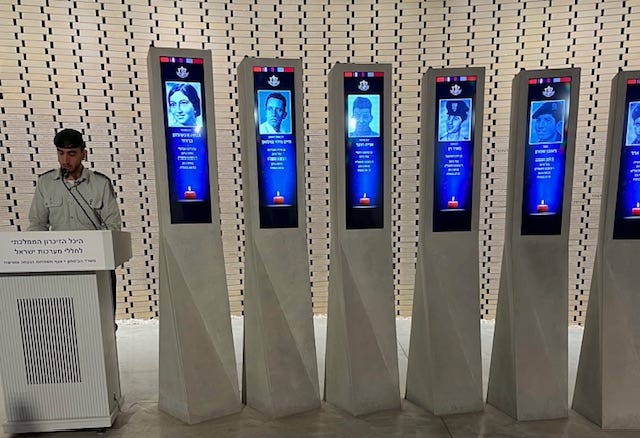Telling The Story Of Israel’s ‘Unknown’ Soldiers
As the war grinds on, so do efforts to learn more about those who preceded today's heroes.
Peaceful and disturbing: the cemetery at Mt. Herzl is lovely. But so many graves…
Jerusalem – “No soldier left behind” is a solemn pledge the Israeli military makes to its soldiers. “Wherever you are, whatever happens to you, we will find you and bring you home.”
Even as the nation prays for and debates how best to assure the safe return of soldiers held hostage in Gaza, a little-known non-profit continues to fulfill a unique form of the “no soldier left behind” promise that applies to those who gave their lives for the Zionist cause more than 75 years ago.
Some 80 volunteers, most of them amateur genealogists, are members of a group called
Latet Panim Lanoflim, or “Giving A Face to the Fallen,” dedicated to filling in the details of the lives of more than 1,000 “unknown” men and women killed in Israel’s War of Independence, in the late 1940s.
“These people gave their lives to fulfill the Zionist dream, and the least we can do to honor their memory is try to learn who they were, what they looked like and where they came from,” explained Stephen Glazer, a retired social worker, as he led my wife and me through the section of the hauntingly beautiful grounds of Mt. Herzl, the site of Israel’s national cemetery, where those who fell during the War of Independence are buried.
Glazer, deeply devoted to the cause, pointed out several gravestones that lacked photos of the deceased and/or did not include the names of parents or provide any biographical details.
Many of the fallen here, he explained, were young immigrants who escaped war-torn Europe by themselves, somehow made their way to Palestine, were, in effect, given a gun and sent off to join the greatly-outmanned fighters of the Haganah, the forerunner of the Israel Defense Forces. Tragically, more than a few of these lone soldiers of their time were killed in battle soon after they arrived - at ages as young as 16 and 17.
“We want to know where they were born, what they did in their short lives, who they left behind,” Glazer said. Through research, attempts to locate family members, interviews and examples of good fortune, about 350 unknown cases have been “solved,” he said, resulting in updated and additional entries on the organization’s website and often, restored tombstones.
In all, more than 24,000 Israelis have fallen in defense of the country, going back to the 1870s.
(The fact that the newest graves from the current war are adjacent to those from the period of the founding of the state is a stark and painful reminder that the struggle for Jews to live safely in their historic homeland continues to this day.)
Perhaps the most representative story Glazer shared with us of how persistent sleuthing and a bit of kismet can result in success in filling in the details of the lives of the fallen “unknowns” is that of Tuvia Mermelstein, whose gravestone we visited.
The updated tombstone for Tuvia Mermelstein was dedicated in 2018.
Glazer said he was able to learn during two years of research that Tuvia was born in 1927 in a small town of what was then Czechoslovakia, one of six children. Taken prisoner by the Nazis, he survived the Mauthausen concentration camp in Germany and fled the post-war Soviet regime, making his way through Romania and Italy before arriving in Israel the day after the establishment of the state. He joined the Haganah as a machine-gunner and was killed in a battle to break the Latrun roadblock on May 24, 1948, nine days after his arrival in the fledgling state.
How did Glazer glean these biographical details?
He explained that each year, prior to Yom Hazikaron (Israel’s Memorial Day), when the cemetery is most full, members of Giving A Face to the Fallen leave notes on the gravestones of “unknown” fallen soldiers, hoping that passing visitors may notice and contact them with new information. And so it was that in 2014, a man named Willy Mermelstein saw the note on Tuvia’s grave and contacted Glazer, saying he was Tuvia’s nephew. After a brief conversation, Glazer was convinced that Willy, a physician, had authentic information, so he arranged to go to Kiryat Gat to meet the family. He found that none of the relatives had met Tuvia, but they had a photo of him, and provided a good deal of his biography.
Glazer learned that Tuvia’s parents perished in the Holocaust but his brothers survived and came back to their hometown and eventually immigrated from the Soviet Union to begin new lives in Israel.
In 2017, Glazer said, he received a message from a guide at the cemetery with information about a man living in Jerusalem named Yitzchak Sherman, then in his mid-80s, who said he had been a close friend of Tuvia. Glazer went to see him and learned that Yitzchak and Tuvia met as they made their way to Palestine by train and ship. Yitzchak told him that he and Tuvia were recruited together on arrival in Israel by the Haganah and were assigned to join the ill-fated group tasked with breaking the Jordanian army’s Latrun blockade on the road to Jerusalem. But Yitzchak took ill, stayed behind, and was spared. He said that in their last conversation, an anxious Tuvia told him: “We buried millions and we did not achieve anything. We will sacrifice thousands more, and maybe we will achieve independence.”
Tuvia fell in the battle for Latrun. He was 20 years old.
With this new information, and through the efforts of Giving A Face to the Fallen, a new tombstone was made that included Tuvia’s photo, date of birth and parents’ names. To mark the occasion, a memorial ceremony was held with some 35 family members in the spring of 2018.
“I think of Tuvia as my soldier,” Glazer told us with pride. “His was the first case I solved, and in the process I’ve developed close ties with his wonderful family and with Yitzchak Sherman,” who served in several Israeli wars.
Glazer said that every year on Yom Hazikaron, he visits Tuvia’s grave and tells young Israeli soldiers this story, which in many ways encapsulates 20th century Jewish history: Holocaust survival, the Soviet Jewry movement, Israel’s War of Independence, and the remarkable resilience and depth of commitment among Israeli Jews that lives on, from generation to generation.
Remembering Every Yahrtzeit
A daily reminder: Each day the yahrtzeits of fallen heroes are commemorated with prayers.
Before leaving Mt. Herzl, we visited the National Memorial Hall for Israel’s Fallen, a stunning stone circular building that opened in 2017, and contains on its limestone walls individual bricks with the names and date of deaths of the thousands of fallen heroes honored here.
It is used as “a place of pilgrimage for Israel’s bereaved families, heads of state and the general public to commemorate the lives of those lost,” according to the hall’s website. The walls wrap around a torch-like structure in the center of the Remembrance Hall.
We attended a little-known, brief but very moving memorial service that takes place every morning of the year, except for Shabbat and Jewish holidays, in which those heroes whose yahrtzeit falls on that day are cited, honored, and memorialized with a special prayer and the chanting of the El Maleh Rachamim by an army chaplain.
Often, in addition to the chaplain and an honor guard of five soldiers, family members and others attend and are offered the opportunity to take part in the program. On this day, we and two other visitors were the only ones present as the names of more than two dozen heroes who fell on the sixth day of Shevat were read. Each was represented on a separate screen with a photo and brief biography, spanning the decades.
(The heart-breaking traditional cantorial rendition of the El Maleh Rachamim by the young chaplain seemed to bridge the world of pre-war Europe with contemporary Israel.)
In all, the service, an intimate, dignified recognition of the sacrifice so many have made – and, sadly, continue to make – to ensure the survival of the world’s only Jewish state was one more tender reminder of Israeli society’s devotion and commitment to an army made up of its children and grandchildren.







Today with new methods in the world of DNA, many of these unknown soldiers can be identified. Just need permission to open the grave, take a small sample, close the grave and hopefully, the identification will now be complete.
When I visited Naomi Shemer's grave several years ago, I saw a few graves that were labeled Ploni Almoni [John Doe] age [age noted]. I thought it unusual that age was known, when name wasn't, but in any event, it was a testament to the fact that Israel has any number of 'unknown soldiers.'